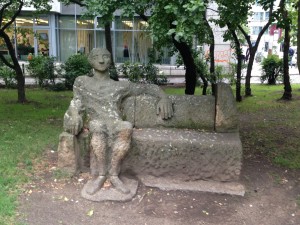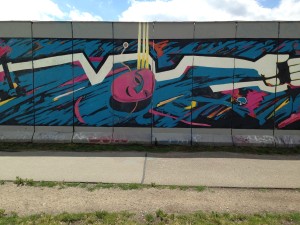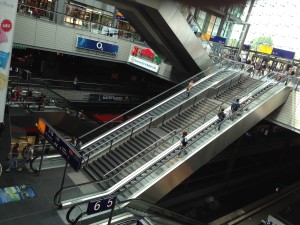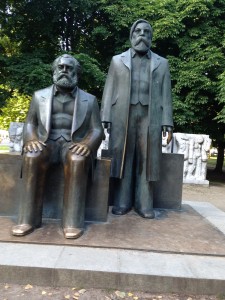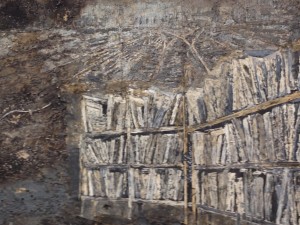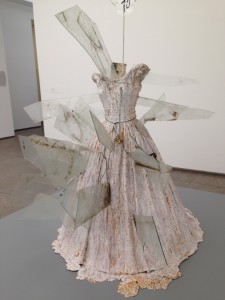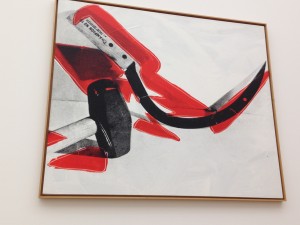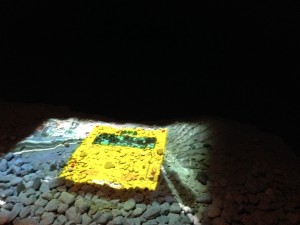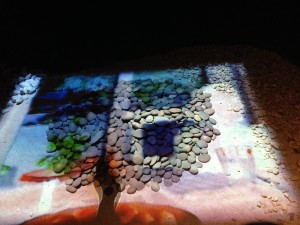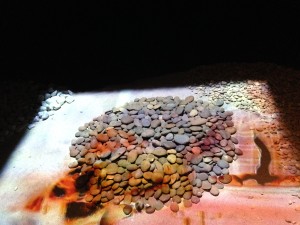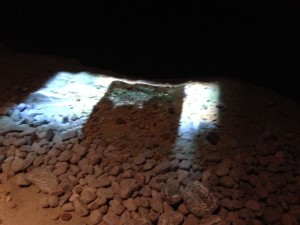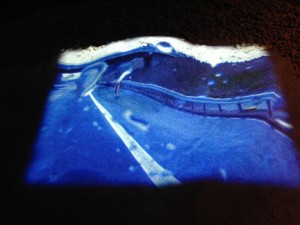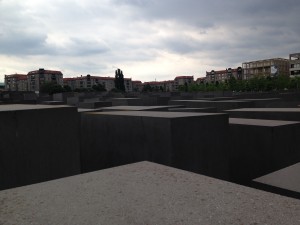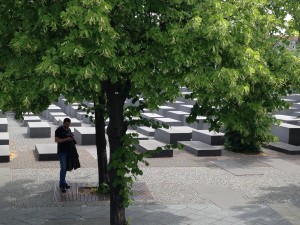The train ride to Berlin from Prague is long and easy. The taxi from the Hauptbanhof to the Adina Apartment Hotel, near the Hackescher Market in Mitte, is quick. The neighborhood is supposed to be lively, including nightlife 24/7, but it looks so staid that the driver has to reassure us.
Our room on the sixth floor turns out to be an entire small apartment designed in unadorned clean lines. Our living room window overlooks an intersection of small roads with light car traffic. Pedestrians flow together and apart in an intermittent pattern. Most walk singly; some are pairs or small clusters with an occasional dog or kid. Every once in a while folks stop to chat, but mostly everyone heads straight on, determined to reach a destination.
And there are bikes, one or several of which are in view at any given instant. Cyclists are upright, equipped with briefcase for the day and/ or shopping bags for the evening. Quick and efficient, they pedal into and out of the intersection from all angles.
I go out to find a place to sit for a half-hour meditation. The small park just past the intersection is a quite deserted, a bit unkempt and certainly unlit, with darkness beginning its slow summer descent. The sculpture in roughened concrete of a woman seated on a cement bench has a commodious space beside her, so I am tempted, but a bit further on twisted concrete figures with vague features emerge from the ground, agonized.
No sculptor’s name, no plaque that explains anything, just the grim reminder. Of what? The Holocaust? The hand-to-hand combat in this area as World War II wound down? The general angst of life? All of the above it seems to me.
I find a bench near a tram stop where I am more comfortable, and the next day I return to that area for my half-hour walking meditation. Two sidewalks bisect a planted rectangle in front of an entrance to what appears to be a school for young adults. People alight from and embark on the nearby trams; it’s an active place. But when I look into the dark vegetation, again there are the mementos.
This time one cement figure is a woman on her knees, hands behind her back, in chains. On the other side is a Giacometti-style duo, with the standing figure delivering a severe a punishment to the one that’s down on the ground.
Still, throughout our stay here I walk on this path and I sit on this bench, and I enjoy the peaceful swirl of what used to be East Berlin around me.
On our first full morning we stroll to Alexanderplatz. At this hour the huge square is quite empty. The first tourist attraction we see is a two-day, hop-on-and-off-the-bus-whenever-you-want-to-tour. We hop on and settle on the top level in the fresh air, right behind the guide.
He is a sorta scruffy counter-culture type middle-aged German guy, who draws our attention first to the Fernsehturm, a TV tower built by the communist German Democratic Republic (GDR). The needle, beneath which is a revolving restaurant, forms the highest human-made point in Germany. Our leader does not talk about the food, or even the view. Instead he describes the way the GDR used the tower for surveillance of everyone and everything, We never consider going back there to eat.
Next come the fragments left from the Berlin Wall, which the guide tells us are the largest tourist draw in the entire city. The sides of the Wall that fronted West Berlin were said to be the longest canvas for continual art in the in the world. Most of the Wall has been destroyed since 1989, but when we descend from the bus to stroll along what’s called the East Side Gallery, colorful murals still adorn an impressive length of what’s left.
Most famous, I suppose, is a huge painting of a kiss between Leonid Brezhnev (head of the USSR) and Erich Honecker (head of the GDR) from a 1979 photograph taken at the 30th anniversary celebration of the GDR’s founding. I could not take my eyes off this thing. What can I say? I have no idea what actually went on between these two, but this kiss, the one in the painting? It is sensual, just about to the point of lust.
Our bus takes us through various areas of what had been working class East Berlin. Our commentator mentions Rosa Luxembourg, and a street and square are named after this labor leader who was executed in 1919 by the German government.
Occasionally he points out two parallel tracks of narrow rectangular cobblestones in a darker shade which mark portions of the Wall’s original location.
As for modern Berlin, in what used to be the Western sector, both days on our bus give me the impression of an immense, stony, glassy business area under constant construction. Its scale dwarfs the people on the street, and corporate brands, especially Mercedes, are featured high and huge and loud and clear. The magnitude of all this leaves me a bit cold .
The guide tells us about a model replica of Berlin, crowded with moving toy trains, so eventually we hop off our bus and take on the depth and breadth of the huge shopping mall where this thing is supposed to be.
On and on go the displays of what you can buy, but we know about all that from the U.S., and refuse to be distracted. Finally we locate the hidden elevator to the LOXX BERLIN and ascend to the top floor, pay €12.90 (cash only—don’t be fooled when they tell you Europe accepts credit cards everywhere—not true) to enter a large darkened space that houses an old-timey set of the city in miniature form, with trains moving in and around iconic Berlin landmarks, and planes taking off and landing at the airport.
The exhibits are supposed to be interactive, but I can’t make anything happen with the buttons. The effect of the whole thing is sorta mesmerizing and sorta hokey at the same time.
Fresh from the Triumph of Capitalism in its myriad forms, we return to the Adina and I set out for a walk on my own. In a hidden corner of a nearby park with bunnies in a desiccated small field, I stumble on a majestic statue of Marx and Engels.
Black and white photos have been etched into a nearby metal wall, where they cannot be totally defaced. These include a couple of scenes from the American civil rights movement, which must have been supplied by the Communist Party USA once upon a time.
All of which makes this “red diaper baby” oddly happy. I like the statue with no tourists, and I like it even better when a family of tourists perches on Marx’s lap and leans up against Engels’s chest.
In the middle of the second day we hop off our bus to go to the Hamburger Bahnhof Museum of Contemporary Art. The bus driver tells us it’s “right over there,”but we undergo a half-hour march, with much uncertainty, even to get to the place. Finally we walk up a massive avenue to a massive front door with a massive wooden blue man sitting there, pensive, his elbow on his knee, his palm cradling the side of his head.
All this makes us hungry, so instead of going in we hang a right, to check out the museum café.
We sit and chat, and eventually a waitress shows up. She gives us menus, retreats, and eventually she shows up again. If we have questions by now we’ve learned to guess at the answers. Because so far in Berlin restaurants when there are such inquiries the wait person says oh, just a second, and disappears.
Eventually, when we have supplied our own answers and figured out what we want, the waitress returns. Orders given, orders taken. Then a LONG pause and finally the food comes. Again our experience here has been that no one asks whether everything is all right, and if it isn’t, you have to work at getting anyone’s attention. But everything is fine. Next after a LONG pause, finally the dessert comes. And after another LONG pause, the check arrives, and believe me, by now we are ready to pay at once.
By the end the customers are as relaxed as the wait staff, because there’s no other choice. I come to like all this, so different than the way our American restaurants run. Then again, we are on vacation. We have nothing but time.
The first room of the museum has massive paintings by Anselm Kiefer and Andy Warhol. Kiefer’s work covers whole walls and portray Jewish dispossession in a blur of fragmented brown and gray.
But it’s his three-dimensional full-size freestanding gauzy dress that sticks with me. Pink and soiled and pierced by shards of glass pane, I expect this to refer to a specific woman, or maybe even women in general. But no, it’s more than that. The title is “Schechina,” the Hebrew word of the feminine aspect of G-d.
Warhol is on full display with a large Marilyn Monroe and another of his signature colorful flowers. What draws my attention most is his smaller “Hammer and Sickle,”in red and black, which I have not seen before.
The entire place is cavernous, with lots of zones to traipse through, and many odd displays to contemplate.
A life-size model of an art nouveau apartment from the 1920’s makes me chuckle because it’s so similar to our very own Adina apartment.
The central vaulted space of the old railway station creeps me out a bit. In a corner are young women with a questionnaire designed to ascertain which people would keep their word, no matter what, and to give them a way to connect directly with each other if they wish. I don’t even want to see if I qualify, let alone be in contact with the others.
What I like the best is a large dark room with squares of light on the floor that contain shimmering shapes of color and form. These intervals lead back into pre-and sub-consciousness, and comfort me on a level that is not analytical. I didn’t even write down the name of the artist, and later I could not find it anywhere.
On the third morning the Adina’s breakfast buffet—eggs cooked to order, bacon and sausages, smoked salmon, bagels and rolls, goat cheese and berries, juices and teas and coffee choices, pastries to the nth degree—leaves us stuffed and confident.
Of course we can handle bikes in Berlin! And right in front is the easiest bike rental I can remember. The price—as with everything about the Adina—seems reasonable. €12 for 24 hours, paid in cash. Each bike comes with three speeds, thick tires, hand and foot brakes, and a huge chain and lock—what’s not to like?
We take off and immediately understand that we are the least efficient bikers on the road. Everyone else knows where they are going and they pedal quick and smooth to get there. We typically ride at an uncertain pace, stop a lot to figure out where to go next, and no doubt are a nuisance for other riders. Nicely, no one complains.
We go to the Neue Synagoge first thing, because it’s close. Security tells us to park the bikes across the street, security lets us into a locked door, security gets us through a metal detector and security searches my purse. Once inside there is printed material with facts like this:
Built between 1859-1866, with a main hall that seated 3,000, this was the largest synagogue in Germany.
The Jews were not required to wear distinctive clothing or stay within walls; in fact the rabbis played a political role in the life of greater Berlin.
Due to an unfavourable alignment of the property, which could not be changed, the building’s design required adjustment along a slightly turned axis.
Albert Einstein played the violin here in 1930.
AND? The first woman rabbi in the world, Regina Jones, ordained in 1935, was here! Not permitted to give sermons from the main bima (altar), she nonetheless performed weddings and presided at the smaller shabat services. Before the Nazis ruined it all…
…by rampaging through the whole place on krystallnacht. (Amazingly, the local police chief managed to get the thugs out, summon the fire brigade and save the building from being burned.)
…by choosing the Jewish New Year season in 1940 to requisition the main space for a leather warehouse. (The few services held after this were in side rooms).
…by causing a war that brought allied bombers to Berlin, who destroyed the whole building.
…by yanking Jews out of their homes, requisitioning their property, deporting them to concentration camps, and gassing them.
Regina Jonas, for example, had to fill out a declaration form that listed her property, including her books. Two days later, everything was confiscated, and the next day, November 5, 1942, the Gestapo arrested and deported her. She died in Auschwitz at the age of 42, in late 1944.
Throughout the neighborhood now are scattered occasional square golden cobblestones that list a name, date of birth, date of deportation and date of death. Thus, a few are commemorated.
Next, preoccupied by all this, we bike across the Spree River to see the “Memorial to the Murdered Jews of Europe.”
Once in the vicinity there is no way to ignore this extensive area (4.7 acres) packed with gray metal coffin-like boxes of slightly varied sizes. These march off in bleak rows, separated by level aisles in one direction, and undulating along small hills in the other. The slate surfaces are smooth, soothing to the touch if you forget what they are about.
I wander in, sense that I could get lost there, and edge back out. The setup conveys an unending suffering, a relentless grief.
We bike through the Tiergarten, the main park of Berlin, which even in full sunlight, like the other parks in Berlin, seems neglected in places, and a bit foreboding. But maybe it’s just my mood…
After all this and a break at the Adina we head off to find an interesting place for dinner. We bike from the Adina across the Spree River again and eventually stumble on a café that is a bit down and out and more friendly than most, which is enough to entice us in.
I settle into the casual pace of service and stare at the passersby. Suddenly I realize that every single Berliner I see—men and women both—are wearing black. Inky fabrics cover spare and zaftig frames alike. Whites and colors, if included at all, are only for accent.
The café is communally owned, the vibe relaxing, the food ordinary and nicely inexpensive. The owner tells us there is a jazz quartet tomorrow night that has been playing there twenty-five years, and we resolve to return in the hope of good music and conversation about what it was like in the olden days, before and after the Wall.
So the next evening, in the receding solstice light, we find our way back to the place on foot, and descend down two sets of concrete steps and through various concrete rooms until we arrive at the innermost claustrophobic cellar of all. Maybe this was one of those adventurous clandestine clubs during the GDR? Now the air is close, the stone walls and floor dingy. I wonder how we would all get out in an emergency, then resolve not to think about that again.
The music turns out to be old white-guy Dixieland jazz, which can be good in fact, but this was pretty awful. During the break I approach the trombonist, who is talking with a woman friend. She stares at me as though I’m intruding, which perhaps I am? Perhaps it’s a rare assignation between sexy sexagenarians, right there in front of everyone, and they need their privacy?
Nonetheless, I interrupt nicely with my question planned to break the ice—“Excuse me, but we were wondering. Could one play jazz in East Berlin before ’89?”
“Yes,” the man answers, “But I didn’t know much about all that. I was always in the Western sector.” His manner indicates that I should have understood this from the getgo. Next he returns to his private conversation, and oh well.
On our last full day, in the midst of a massive downpour, we make it to Kreutzberg, originally a counter-culture center just west of the Wall and now reputed to be a diverse community. We take the train, marveling on the ease of public transportation in this city, then trudge down from the raised station, get lost, find the right direction and continue. Despite windbreakers, hiking shoes and one huge Adina umbrella, we get drenched.
We take refuge in the first coffee shop we see, which has black African youth hanging out in plastic chairs under the front overhang. Inside, counting the baby in a stroller, is the three-generation Arab-looking Muslim family that runs the place. We order coffee with cream and soft sugary pastries, and settle down onto wooden chairs next to a table with a plain white cloth.
Outside the young men linger, and the owners don’t seem to mind. When the downpour turns to drizzle, careful to throw out their cups and napkins, the kids get up to leave.
We head for a nearby park, and this one looks so desolate we turn back before we even get to the trees.
We return to the café, and by now there is a tall rangy well-into-middle-age gray-haired German guy, wearing black of course, who proclaims himself a writer. We ask what he writes, and I hand him a business card about my own novel, “Tell No Lies.”
“Yes!” he exclaims. “Exactly that! I write of the truth, all the way down to my last day, because no one will know the full truth until then.”
After that, as seems to be our pattern with Berliners and substantive talk, there’s not much more to say.
We set off on the long wet slog back to the train station. There everyone commiserates pleasantly about the rain. Small talk. Lovely.
That evening, after I have changed into dry clothes, meditated out in the rain, gotten soaked once more despite all precautions, and changed yet another time, we try another jazz place. This group, all white again, plays an intricate set of improvisations that are complex and austere and lovely. No blues-based inflection, though. Nothing that makes me regret leaving town tomorrow.
In the train station the next morning, when I find my European edition of the NYT, I ask the woman selling papers about the storm the day before. She has never experienced so much rainfall in one day, she asserts, and she has lived in Berlin all her life. And I realize that during the whole day I had seen people walking quickly, running, sprinting, biking, with few umbrellas, jackets or hats, racing through the furious rain to get where they wanted to go.
An intense weather event, heightened by climate change? In any event, this morning it is clearing, and we are on the platform in plenty of time to catch our train to Amsterdam.
